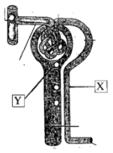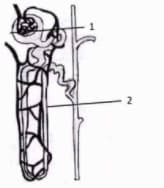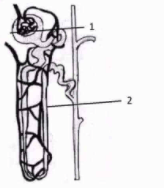HARD
Earn 100
Explain the physiology of urine formation.
Important Questions on Excretory Products and their Elimination
HARD
EASY
The diagram given below is that of a structure present in a human kidney. Study the same and answer the questions that follow:
What is the fluid that comes to part ‘2’ called? Name the main nitrogenous waste in it.
MEDIUM
In the given diagram of urine formation, which process occurs in X and Y?

MEDIUM
EASY
HARD
EASY
MEDIUM
HARD
Match the following ?
| List I | List II | List III | |||
| (i) | High threshold substances | (a) | Not at all reabsorbed | (p) | Creatinine |
| (ii) | Low threshold substances | (b) | Efficiently reabsorbed | (q) | Glucose |
| (iii) | Athreshold substances | (c) | Reabsorbed in very little amounts | (r) | Urea |
EASY
HARD
| Column – I | Column – II (Part | ||
| Function | Part of Excretory System) | ||
| a. | Ultrafiltration | i. | Henle’s loop |
| b. | Concentration of urine | ii. | Ureter |
| c. | Transport of urine | iii. | Urinary bladder |
| d. | Storage of urine | iv. | Malpighian corpuscle |
| v. | Proximal convoluted tubule |
MEDIUM
(i) Close proximity between Henle's loop and vasa recta
(ii) Counter current mechanism
(iii) Selective secretion of and hydrogen ions in
(iv) Higher blood pressure in glomerular capillaries
EASY
HARD
EASY
EASY
MEDIUM
EASY
The diagram given below is that of a structure present in a human kidney. Study the same and answer the questions that follow:
What is the liquid entering part ‘1’ called? Name two substances present in this liquid that are reabsorbed in the tubule.
MEDIUM
EASY



